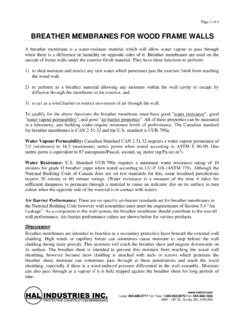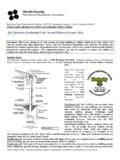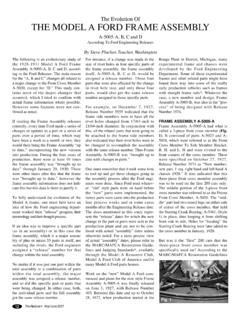Transcription of 1 Short Frame Scouts Down Under - Parker Indian
1 1 short frame scouts down under Indian introduced the model G scout in 1919 and it evolved over more than a dozen years til the factory dropped the model after 1931. I regard all Scouts produced between 19 and 31 as Model Gs , or Vintage Scouts , the 101 model being simply the final form of it. This article is about the 1926-on models, and some differences I have observed between them and the 101 introduced in mid 1928. In 26 the engine numbering system was changed from an awkward one to a much simpler system. ( Frame numbers were not introduced until 1931, so the eng. # is the method of model/year ID) Eng #s covered are AG -1926, 37 , Short Frame BG 1927, 37 , Short Frame BGP 1927, 45 (new eng. size) Short Frame CG 1928, 37 Short Frame CGP 1928, 45 Short Frame DG mid 1928 on through 29, 37 , new long Frame DGP mid 1928 on through 29, 45 , new long Frame EG 1930, 37 , long Frame EGP 1930 & 31 45 long Frame Tracking the differences in the earlier models from the Scouts introduction till the AG model will be the subject of a later article, and it is even more difficult to plot these changes.
2 My purpose for writing my thoughts on the subject is that I find that there is very little knowledge on the topic, and with the greatly increased interest in the 20s models, perhaps a few commonly held misconceptions can be put right. These are my thoughts, based on my observations. Substantial numbers of the twenties model Indians were sold down - Under (Australia and New Zealand), and many have survived, in contrast to what appears to me to have been the situation in the US. 2 There are very good reasons for this. Australia in the 1920s was like America, with the exception that it did not have a great manufacturing capacity, and virtually all motor vehicles were imported, or assembled locally from imported components. The country itself was very similar to America in that it had huge distances, no existing road system and extremes of great heat and rainfall.
3 The product developed for use in America could well have been developed just for Australian conditions. Extremely rugged and durable machines contrasted with the machines available from mother England nimble and light, designed where there was a pre-existing road network, and not the great distances, heat and the isolation. The car did not really become available for the common man in OZ until the middle 1950s they were all imported, and expensive. A motorcycle was just that little bit cheaper, and an Indian scout , or J-model Harley Davidson, both with a sidecar attached, could provide transport and communication with the towns for a farming family. The sidecar was usually locally produced, typically by the Goulding family (before they immigrated to the US) and the Dustings factories in Melbourne, but there were other smaller concerns.
4 Earlier machines had genuine chairs, made by the same company that made the motorcycle, but once these local companies began production they received protection from the government, and sidecar imports were banned. (Bearing in mind that our sidecars were on the wrong-side re America, I wonder how upset the factories really were?) They were kept in service for many years, and when the family ultimately obtained a car or other mode of transport, they were usually put aside , rather than sold and eventually fell into the hands of the boys on the farm, and became what we call paddock bikes . Because they were such rugged reliable machines, and would keep going and going, even with major components missing or not operating, these machines were often literally ridden into the ground . This is why we find most machines in really terrible condition when restoration time comes around they are completely worn out in every component the entire power plant (with the exception of the primary drive), wheels, brakes, suspension, all linkages and bushings etc.
5 3 Missing are the luggage rack, tool and battery boxes, chain guard and generator belt guards, often the generator itself anything the young rider would have had to remove to repair a broken chain, or perform any other form of fix-it and not be required back on the machine in order to make it go . This also created another problem, which brings us back to what this article is all about identification of the different features of the different year models. There was great interchangeability of components between models. If your neighbors crashed machine had some bits that yours needed, especially those modern better performing detachable heads and cylinders, or his earlier primary and transmission to replace your blown that wheel, to replace your buckled This often results in The machine has been in the family all its life, and would be correct from the when in fact it was upgraded during it s years of service, or that later or earlier component was fitted to keep it going, or because current custodian simply liked the different part.
6 The factory made contributions to the clouding of this issue as well. Firstly, running changes were introduced, and while these changes might have been announced as ..improvements to the new they had in fact been in production a little while earlier on the previous model the marketing people doing their job! Secondly, when a new feature was introduced, none of the now obsolete components would have been discarded they would have been used-up . Now, what would be the best thing to do if you had a few machines that still had the old features, or a mixture of both, and you d made a big fuss about all these changes on the new model .. I order for won t have found about the changes yet, and anyway, it s too far to send them The 1926 scout was still called the model G, (like all Scouts since 1919) in fact, the model AG.
7 All had the 37 engine, and the engine # pre-fix was AG. !927 was the model BG, and saw the introduction of the 45 engine, which was model BGP The P meaning 45 , also known as the scout 45. Apart from the power plant changes, the two machines (the 37 and the 45) were ostensibly identical, with the exception of the brakes. The 45 was available in two models, the Police Special and the Sport Solo. 4 The 45 model is very rare in Australia, and I think the world. I have only seen a couple that I rate as genuine. (Why a couple of bucks more than the 37 , too much for us poor ) I think that the various options for handle bars etc were available with either engine size. The 45 still had the pedestal front engine mount of the 37 , as in all previous Scouts . That is, two ears cast as part of the crank case. The 45 cases were I believe interchangeable with the 37, but the flywheel assemblies, conrods, cylinders and heads were obviously different, because of the different bore and stroke.
8 The larger Chief crankpin was used in the 45, and the heads were retained with seven rather than the six stud and nut assemblies of the 37. The 45 got the bigger Chief clutch basket and clutch. This required a change to the primary drive gears, and cases. I believe the actual gears in the three speed gear box stayed the same. Note - Indian called the primary case the transmission . The front hub stayed the same in both models, as per the 26 year. The rear was different. The 37 stayed the same as model AG, internal band and external band for the foot and the hand brake. on the right hand side. (Note all Australian models had to have two independent brakes for registration domestic USA models did not.) But the 45 was changed to the Chief set up, internal half shoe and external band on the left side. This required a cross-over shaft on the Frame behind the power plant, and consequent dimple in the primaries.
9 Otherwise, the general cycle parts were the same for the 37 and the 45. The 45 drum was not enclosed- plenty of dirt etc found its way in, and as such, usable drums are now very hard to find, especially so because both the internal and external surfaces of the drum were used for braking. The wearing surfaces of the drums have been hit from both sides! 5 The front fender of both models had more valance than the AG, and was secured with two large P-clips to the main fork tube. The rear also had more valance, and extra stays. The LH rear stay was also removable to aid with rear wheel removal. The wire to the taillight was now contained in a metal tube, running along the outside of the fender. The links from the spring to the rockers now passed outside the fender, rather than through it. The decompression lever passed through a hole in the tank, instead of a bracket bolted to it.
10 The Australian machines were all colonial models, so as well as the two independent brakes, had a luggage rack, front as well as rear stand, and of course, Indian Red paint no options! In September 1927 Indian introduced the 1928 models. The 37 was model CG, and the 45 CGP. There were major changes across both models and some changes to the 37, to bring it into line with the 45 an obvious production rationalization. The heavier Chief front hub was introduced to both models, so now the Four, Chief and both Scouts used the same hub only the Prince was different. The 37 received the same clutch and primary as the scout 45 and the Chief and Big Chief, more rationalization. Chief and scout clutch plates were to remain basically the same parts until the end of production, although the configuration within the clutch varied a little.






